
Automated decontamination methods help to reduce the risk of hospital-acquired infections (HAIs). Using these methods alongside manual cleaning provides hospital cleaning staff with the reassurance that they are creating the safest possible environment for patients, visitors and staff.
But these automated decontamination methods, such as those using hydrogen peroxide vapour (HPV), can take several hours. And in a busy environment with high numbers of patients, the challenge is ensuring that hospital services and patient flow are not disrupted whilst the decontamination process is carried out.
In this blog post, we explore four strategies that maximise the effectiveness of decontamination whilst ensuring minimal disruption to hospital services.
1. Proactive Cleaning Programmes
The implementation of a proactive cleaning programme can significantly reduce the rate of infection within the hospital environment.
Patients who are colonised with C. diff for example, tend to use specific areas (e.g. toilets) more frequently, which can lead to a higher risk of spreading the infection. With a proactive cleaning programme, a UV-C device can be used to decontaminate these areas whilst patients are in another area. The process can take just 10 minutes, depending on the size of the room.
Close engagement with hospital staff is required to keep the programme flexible around day-to-day needs and changing priorities.
2. Patient Equipment Cleaning (PEC)
A Patient Equipment Cleaning (PEC) centre can be greatly helpful in assisting cleaning staff in the decontamination of medical devices, communal patient equipment, and non-ward based equipment such as transfer trolleys.
Equipment is brought to the centre to be cleaned and disinfected so it’s ready to use again. When the equipment is taken from the room to be cleaned as soon as the patient is discharged, it allows for the ward to be turned around faster and for automated decontamination to take place if necessary.
If a hospital has an efficient PEC centre, then the implementation of dynamic discharge cleaning can also be considered.
3. Dynamic Discharge Cleaning
Dynamic discharge is an approach designed to improve the timeliness and quality of patient care by planning and synchronising the day’s activities. When a patient is discharged, the equipment can be taken to the PEC so the automated decontamination process using UV-C or HPV can start right away.
Dynamic discharge cleaning can save a significant amount of time. However, it does rely on a hospital having additional space for PEC centres and access to spare rooms where patients can be moved to.
4. Red-Amber-Green (RAG)
Using a RAG (red-amber-green) assessment system can provide a quick solution when dealing with an infection problem. It helps cleaning staff to determine whether manual cleaning alone will be sufficient or if an automated decontamination method is required. This prevents any time being wasted by carrying out automated decontamination when it is not necessary, so the ward can get back to normal as quickly as possible.
For example;
- Following the discharge of a patient with C. diff or Norovirus, a Red Clean involving HPV decontamination would be required.
- Following the discharge of a patient with MRSA or tuberculosis, an Amber Clean involving a chlorine-releasing agent would be required.
- Following the discharge of a patient with no known infections, a Green Clean using detergent or standard cleaning solution would be required.
Every hospital wants to create a safe and clean environment and to reduce the incidence of HAIs. The strategies outlined in this blog post ensure maximum effectiveness of decontamination whilst improving patient flow and minimising disruption to hospital services.





